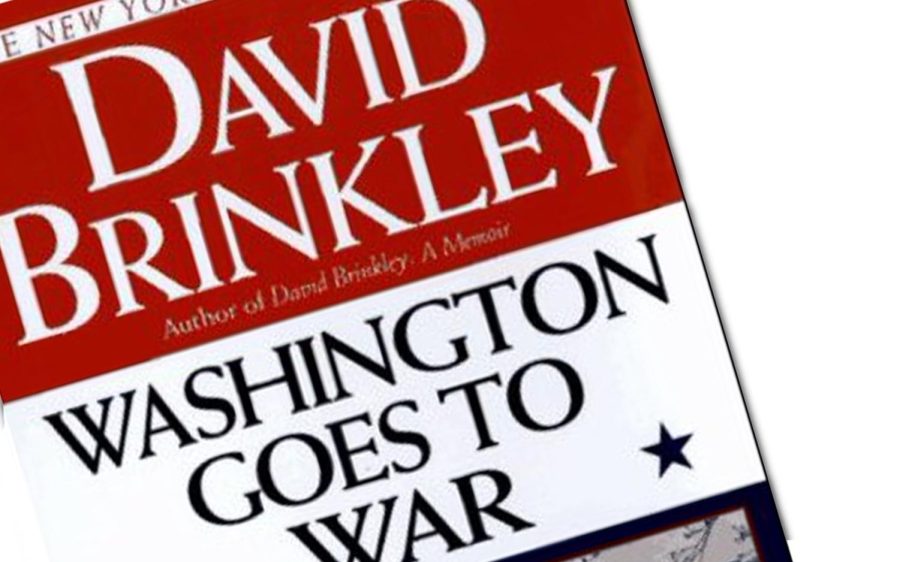Notes & Quotes: When Washington went to war; reviewing our past in light of today
April 1, 2022
As the winds of war once again begin to blow, it is interesting to take a look back at how our nation became the world’s leading armed force. There are numerous historical resources to call upon, but one book I first read some 35 years ago chronicles just how unprepared this nation was for our defense, let alone launch any sort of offensive movement.
Legendary newsman David Brinkley’s 1988 nonfiction book “Washington Goes to War” offers extraordinary details of how unprepared we were in the 1930s when Germany, Italy and Japan were rattling swords. The famed news reporter and later NBC commentator on the nightly “Huntley-Brinkley Report” began detailing how antiquated equipment was in U.S. Army.
 If President Roosevelt had looked closely during his many inspections of bases across the nation, “The president would have seen some unsettling sights. … Tanks had truly horrendous designs … there were no periscopes. … the soldier driving the tank could not see where he was going … the commander had to sit in the open (on the turret), shoulders and head exposed, resting his feet on the driver’s shoulders. To guide the vehicle the commander had to kick the driver on the left shoulder for a left turn and the right for a right-hand turn.” However, Brinkley did point out each tank was equipped with a siren.
If President Roosevelt had looked closely during his many inspections of bases across the nation, “The president would have seen some unsettling sights. … Tanks had truly horrendous designs … there were no periscopes. … the soldier driving the tank could not see where he was going … the commander had to sit in the open (on the turret), shoulders and head exposed, resting his feet on the driver’s shoulders. To guide the vehicle the commander had to kick the driver on the left shoulder for a left turn and the right for a right-hand turn.” However, Brinkley did point out each tank was equipped with a siren.
When Col. George Patton arrived in Georgia to assume command of the 2nd Armored Division, he found most of his 325 tanks were in disrepair and in desperate need of nuts and bolts to hold them together. When the Army supply department ordered them, but never arrived, Patton got out a Sears, Roebuck & Co. catalog and bought and paid for them out of his own pocket, Brinkley described.
But fear not, dear readers. Patton was the wealthiest man in the Army. He came from a rich Pasadena family.
Roosevelt should have noticed at a Texas Army base there still was a cavalry. The commander of the post had just ordered 1,000 horses for a 1,000 new soldiers who had never seen a horse. … No worries, most of the horses had never seen a man. The commander wasn’t concerned that that month in 1939, German panzers (tanks) had destroyed the 3,000-man-and-horse Polish cavalry in a matter of minutes.
Gen. George C. Marshall was destined to lead 7 million soldiers, the largest fighting force the world has ever known, but in the late ’30s, he commanded a dusty post outside of Leavenworth, Kansas. He was supposed to have received command of a full battalion (500 men). However, Brinkley’s research revealed Marshall had barely enough men to cover the duties of a battalion, “which included 200 soldiers made up primarily of cooks, and potato peelers.”
During one Army command’s 1940 field maneuvers, soldiers had to sleep on the ground. They begged for ammunition to put in their 1910 caliber .303 rifles in order to protect themselves from prairie rattlesnakes. The requests were always denied. As one supply sergeant observed those old bolt-action rifles made before World War I and still in use could cause bodily harm.
“Firing a (1910) round that old in a rifle that old might hurt you more than it would hurt the snake,” he would tell soldiers.
Washington wasn’t without its political humor leading up to World War II. In a Congressional budget hearing, a senator asked a general why the Army needed so much money for enlisted men to do household chores for the officers.
“Sir, would you like to see a general in the U.S. Army out pushing his own lawn mower?”
“Well, sir, I’m a senator of the United States and I push my own lawn mower.”
It was 1941 when construction finally began on the Pentagon. It began once a location across the Potomac River was settled upon, which was no easy task. Roosevelt objected to earlier proposed locations because they were too close to Arlington National Cemetery. Once war was declared on Dec. 8, 1941, offices began being occupied military personnel while construction was going on.
Brinkley’s firsthand observations are a very short glimpse of what everyday life was like in Washington, D.C., during those years leading up to the War. At that time, the nation’s capital was a sleepy, Southern city where things didn’t move very fast. But as the wheels of government began mobilizing for war, the pace would quicken in short order.
By the end of the War, which was the greatest conflict in human history, some 16 million Americans had been in uniform and thousands of defense factory and shipbuilding workers provided vital weapons and ammunition in support. Life in our nation would never be the same. The U.S. emerged as the world leader in military power with overwhelming air power, the world’s largest navy and advanced weaponry. We’ve managed to hold on to that lofty position. It remains to be seen whether our position for the world will last.
For casual readers of history, I recommend “Washington Goes to War” if you can find a copy. Amazon.com still has it available.
Tom Morrow is a longtime Oceanside-based journalist and author who contributes to OsideNews.
Columns represent the views of the individual writer and do not necessarily reflect those of the North Coast Current’s ownership or management.





